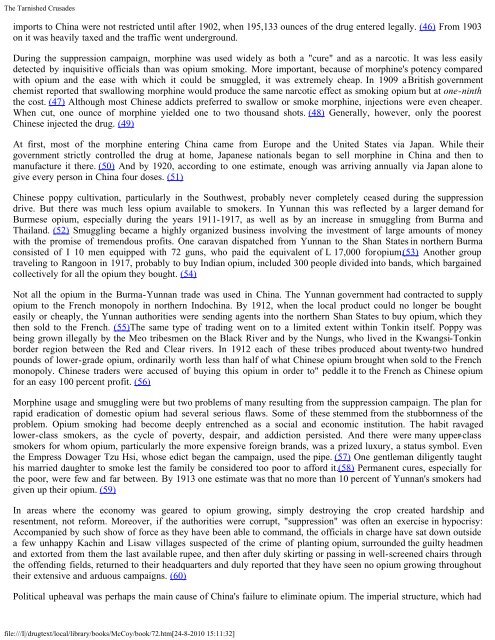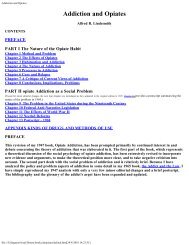The Politics of Heroin in Southeast Asia
The Politics of Heroin in Southeast Asia
The Politics of Heroin in Southeast Asia
Create successful ePaper yourself
Turn your PDF publications into a flip-book with our unique Google optimized e-Paper software.
<strong>The</strong> Tarnished Crusades<br />
imports to Ch<strong>in</strong>a were not restricted until after 1902, when 195,133 ounces <strong>of</strong> the drug entered legally. (46) From 1903<br />
on it was heavily taxed and the traffic went underground.<br />
Dur<strong>in</strong>g the suppression campaign, morph<strong>in</strong>e was used widely as both a "cure" and as a narcotic. It was less easily<br />
detected by <strong>in</strong>quisitive <strong>of</strong>ficials than was opium smok<strong>in</strong>g. More important, because <strong>of</strong> morph<strong>in</strong>e's potency compared<br />
with opium and the ease with which it could be smuggled, it was extremely cheap. In 1909 a British government<br />
chemist reported that swallow<strong>in</strong>g morph<strong>in</strong>e would produce the same narcotic effect as smok<strong>in</strong>g opium but at one-n<strong>in</strong>th<br />
the cost. (47) Although most Ch<strong>in</strong>ese addicts preferred to swallow or smoke morph<strong>in</strong>e, <strong>in</strong>jections were even cheaper.<br />
When cut, one ounce <strong>of</strong> morph<strong>in</strong>e yielded one to two thousand shots. (48) Generally, however, only the poorest<br />
Ch<strong>in</strong>ese <strong>in</strong>jected the drug. (49)<br />
At first, most <strong>of</strong> the morph<strong>in</strong>e enter<strong>in</strong>g Ch<strong>in</strong>a came from Europe and the United States via Japan. While their<br />
government strictly controlled the drug at home, Japanese nationals began to sell morph<strong>in</strong>e <strong>in</strong> Ch<strong>in</strong>a and then to<br />
manufacture it there. (50) And by 1920, accord<strong>in</strong>g to one estimate, enough was arriv<strong>in</strong>g annually via Japan alone to<br />
give every person <strong>in</strong> Ch<strong>in</strong>a four doses. (51)<br />
Ch<strong>in</strong>ese poppy cultivation, particularly <strong>in</strong> the Southwest, probably never completely ceased dur<strong>in</strong>g the suppression<br />
drive. But there was much less opium available to smokers. In Yunnan this was reflected by a larger demand for<br />
Burmese opium, especially dur<strong>in</strong>g the years 1911-1917, as well as by an <strong>in</strong>crease <strong>in</strong> smuggl<strong>in</strong>g from Burma and<br />
Thailand. (52) Smuggl<strong>in</strong>g became a highly organized bus<strong>in</strong>ess <strong>in</strong>volv<strong>in</strong>g the <strong>in</strong>vestment <strong>of</strong> large amounts <strong>of</strong> money<br />
with the promise <strong>of</strong> tremendous pr<strong>of</strong>its. One caravan dispatched from Yunnan to the Shan States <strong>in</strong> northern Burma<br />
consisted <strong>of</strong> I 10 men equipped with 72 guns, who paid the equivalent <strong>of</strong> L 17,000 for opium.(53) Another group<br />
travel<strong>in</strong>g to Rangoon <strong>in</strong> 1917, probably to buy Indian opium, <strong>in</strong>cluded 300 people divided <strong>in</strong>to bands, which barga<strong>in</strong>ed<br />
collectively for all the opium they bought. (54)<br />
Not all the opium <strong>in</strong> the Burma-Yunnan trade was used <strong>in</strong> Ch<strong>in</strong>a. <strong>The</strong> Yunnan government had contracted to supply<br />
opium to the French monopoly <strong>in</strong> northern Indoch<strong>in</strong>a. By 1912, when the local product could no longer be bought<br />
easily or cheaply, the Yunnan authorities were send<strong>in</strong>g agents <strong>in</strong>to the northern Shan States to buy opium, which they<br />
then sold to the French. (55)<strong>The</strong> same type <strong>of</strong> trad<strong>in</strong>g went on to a limited extent with<strong>in</strong> Tonk<strong>in</strong> itself. Poppy was<br />
be<strong>in</strong>g grown illegally by the Meo tribesmen on the Black River and by the Nungs, who lived <strong>in</strong> the Kwangsi-Tonk<strong>in</strong><br />
border region between the Red and Clear rivers. In 1912 each <strong>of</strong> these tribes produced about twenty-two hundred<br />
pounds <strong>of</strong> lower-grade opium, ord<strong>in</strong>arily worth less than half <strong>of</strong> what Ch<strong>in</strong>ese opium brought when sold to the French<br />
monopoly. Ch<strong>in</strong>ese traders were accused <strong>of</strong> buy<strong>in</strong>g this opium <strong>in</strong> order to" peddle it to the French as Ch<strong>in</strong>ese opium<br />
for an easy 100 percent pr<strong>of</strong>it. (56)<br />
Morph<strong>in</strong>e usage and smuggl<strong>in</strong>g were but two problems <strong>of</strong> many result<strong>in</strong>g from the suppression campaign. <strong>The</strong> plan for<br />
rapid eradication <strong>of</strong> domestic opium had several serious flaws. Some <strong>of</strong> these stemmed from the stubbornness <strong>of</strong> the<br />
problem. Opium smok<strong>in</strong>g had become deeply entrenched as a social and economic <strong>in</strong>stitution. <strong>The</strong> habit ravaged<br />
lower-class smokers, as the cycle <strong>of</strong> poverty, despair, and addiction persisted. And there were many upper-class<br />
smokers for whom opium, particularly the more expensive foreign brands, was a prized luxury, a status symbol. Even<br />
the Empress Dowager Tzu Hsi, whose edict began the campaign, used the pipe. (57) One gentleman diligently taught<br />
his married daughter to smoke lest the family be considered too poor to afford it.(58) Permanent cures, especially for<br />
the poor, were few and far between. By 1913 one estimate was that no more than 10 percent <strong>of</strong> Yunnan's smokers had<br />
given up their opium. (59)<br />
In areas where the economy was geared to opium grow<strong>in</strong>g, simply destroy<strong>in</strong>g the crop created hardship and<br />
resentment, not reform. Moreover, if the authorities were corrupt, "suppression" was <strong>of</strong>ten an exercise <strong>in</strong> hypocrisy:<br />
Accompanied by such show <strong>of</strong> force as they have been able to command, the <strong>of</strong>ficials <strong>in</strong> charge have sat down outside<br />
a few unhappy Kach<strong>in</strong> and Lisaw villages suspected <strong>of</strong> the crime <strong>of</strong> plant<strong>in</strong>g opium, surrounded the guilty headmen<br />
and extorted from them the last available rupee, and then after duly skirt<strong>in</strong>g or pass<strong>in</strong>g <strong>in</strong> well-screened chairs through<br />
the <strong>of</strong>fend<strong>in</strong>g fields, returned to their headquarters and duly reported that they have seen no opium grow<strong>in</strong>g throughout<br />
their extensive and arduous campaigns. (60)<br />
Political upheaval was perhaps the ma<strong>in</strong> cause <strong>of</strong> Ch<strong>in</strong>a's failure to elim<strong>in</strong>ate opium. <strong>The</strong> imperial structure, which had<br />
file:///I|/drugtext/local/library/books/McCoy/book/72.htm[24-8-2010 15:11:32]





